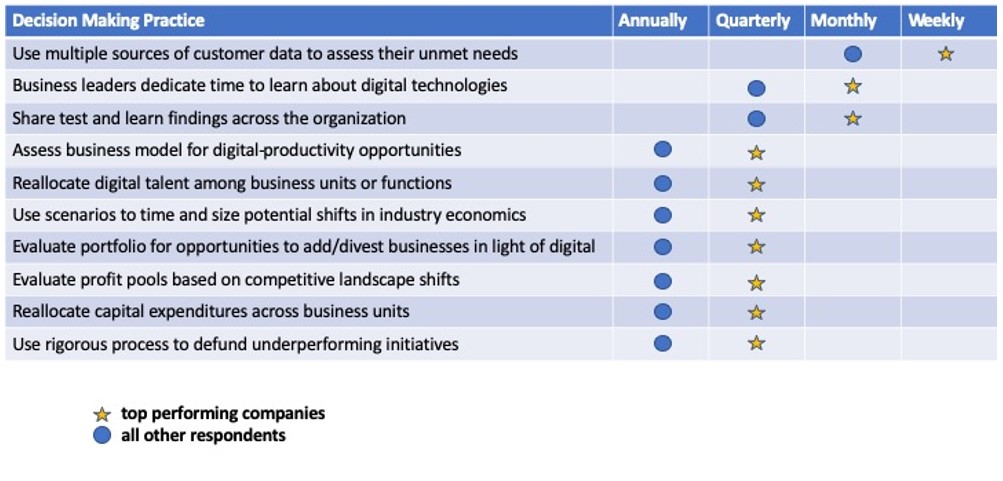
October 25, 2023
In the digital world,
Decision making clarity is a mission critical success factor

The frequency and pace of change from digital disruption necessitates that companies can no longer rely on traditional planning and decision-making models. Simply put, they are too slow, too rigid, and too process driven to adapt to the new speed of business.
- A research study by Bain & Company found that decision making effectiveness drives 95% of business performance
- The UK Institute for Employment found that decision making practices impact 50% of employee engagement
Leaders of successful digital transformation initiatives have embraced decision making clarity as the new competitive imperative. It allows them to adapt, adjust, and when necessary, pivot in real time.
Part of this change involves altering your decision-making model:
Traditional New
Hierarchically structured Horizontally structured
Vertically integrated Cross business
Silo-based Cross functional
To address the new customer value creation chain:
- Cross industry
- Cross category
- Cross channel
- Cross device
- Cross brand
This is completely changing how companies make money. As such, companies must now realign how they make decisions with the new way their customers make decisions.
Speed to market equates with speed to decision making

A McKinsey study asked 1500 executives how frequently they carry out 10 different decision-making practices:

As you can see from the chart above, in all 10 decision making practices, top performing companies increased the frequency and repetition of each one. In doing so, they are acknowledging the necessity to adjust and accelerate their businesses’ decision-making cadence.
Some companies have taken the step of creating and implementing a Just-In-Time decision-making process as shown on the chart below:

All decisions are not created equal
In too many organizations, decision making authority is determined by the hierarchical management structure that supports a silo-based business unit operating model, not by the type of decision that needs to be made. This approach favors short term operating performance decisions over long term business growth decisions.
In some cases, most, if not all of the information needed to make a decision is available and it’s a choice of picking the best option to deliver the desired outcome. In other cases, there is little or no clear-cut data that suggests one approach vs. another. These different cases necessitate different decision-making models and skills as shown on the chart below:

In all cases, it’s critical that you match the right decision-making process to the type of decision that needs to be made. To achieve the right alignment you need to develop, implement and communicate a clear and concise decision-making governance model. This model identifies and delegates decision making rights and accountability throughout the entire organization. It’s built on transparency and trust and is designed to equate decision making accountability with business outcome accountability.
This governance model should also extend to your data management process so it can expedite getting the right data to the right person depending on the specific decision criteria. Achieving operational excellence with both these models and processes should be at the top of your critical priorities list.
Push more decisions to the point of customer contact

The speed and complexity of change from disruptive technologies puts an even greater pressure on the need to change the decision-making clarity of your company. The risks of taking too long to make a decision in many cases outweigh the risk of making the wrong decision especially if you can learn from it and quickly make a new and better decision.
What does seem to be emerging as a faster and more nimble process is to push as many decisions as you can as close to the customer as possible. I think the evidence continues to grow that as computing continues to move out to the point of customer contact decision making has to move to that point as well.
Some clarity in decision-making lessons to be learned
While we are still early stages of this new decision-making journey, I think there are some early lessons to be learned:
- Decision making clarity drives business performance and employee engagement
- Top performing companies significantly increased the frequency and repetition across all major decision-making practices
- Hierarchical management structures and silo based operating models create decision making bottlenecks and roadblocks
- Good decision-making governance identifies and delegates decision making rights and accountability throughout the entire organization
- Edge computing will necessitate the need for edge decision making
- Most decisions should prioritize progress over perfection and quickly share the learning and insights from early experiments or mistakes
- It’s critical to differentiate short term performance decisions from long term business growth decisions
If you have additional lessons you think can and should be learned, please send them to me. As I said, these are still early days in the world of digital decision making so anything you’re willing to share would be much appreciated.
As always, I am interested in your comments, feedback and perspectives on the ideas put forth in this blog. Please e-mail them to on LinkedIn. And, if this content could be useful to someone you know please share it here:



